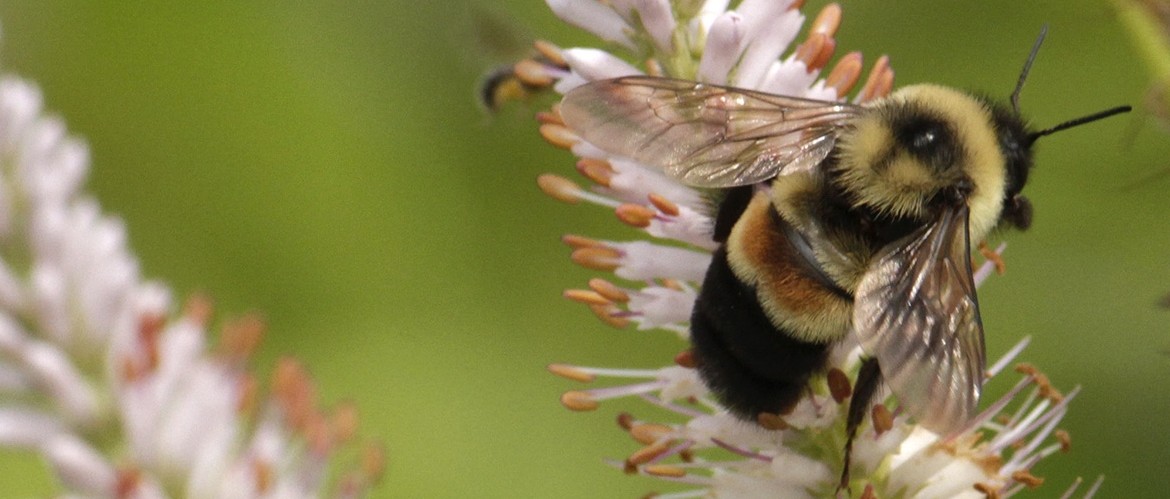RICHMOND, Va. (CN) - The Fourth Circuit was abuzz Thursday morning as environmentalists asked for a second time that a three-judge panel stop a natural gas pipeline from being constructed through the Appalachian Mountains, specifically raising concerns about its impact on an endangered bumblebee species.

Defenders of Wildlife, Sierra Club, and the Virginia Wilderness Committee filed their appeal after the U.S. Fish and Wildlife Service announced a new biological opinion and incidental take analysis approving the construction of a $5.5 billion, 600-mile Atlantic Coast Pipeline, which will bring natural gas from the Ohio Valley through Western Virginia’s Appalachian Mountains to the Atlantic Coast for sale overseas.
The pipeline project is led by North Carolina-based Duke Energy and Dominion Energy of Virginia.
The first biological opinion was challenged at the same Richmond, Virginia-based appeals court. Late last year, the a three-judge panel found sections of a key federal permit ignored environmental regulations for certain endangered species and scrapped the permit.
Pipeline construction stopped in December as Dominion Energy waited for a new permit, but the same environmental groups returned to the Fourth Circuit on Thursday to once again challenge the permit’s impact on species including the rusty patched bumblebee.
Austin Donald Gerken Jr., a lawyer with the Southern Environmental Law Center who argued on behalf of the environmental groups, told the judges that the Fish and Wildlife Service “quickly” reauthorized the new permit and failed to address certain issues raised during both permitting processes.
He also argued that a 2018 survey conducted by the Virginia Department of Conservation and Recreation found that a handful of the rusty patched bumblebees seen in the area marked “one of only five reported sightings outside the Midwest in the last decade.”
Gerken said the agency ignored the new bee data in issuing the second permit, and argued that, along with other errors, should render the permit void.
“Courts do not defer to agencies that ignore the record or new facts,” he argued.
Kevin McArdle, a Justice Department attorney arguing on behalf of the Fish and Wildlife Service, was almost immediately asked about the bees when he approached the bench.
Previously submitted documents touched on the possible number of bee inhabitants in the pipeline’s path. The agency also got feedback from a bee specialist who used the word “wild guess” to describe her estimation, but the agency said it was a “best guess.”
U.S. Circuit Judge Stephanie Thacker, a Barack Obama appointee, brought up this discrepancy as well as the bee expert’s follow-up comments suggesting there could be as many 100 of the endangered bees in the area.
“She said 0 to 100, then she split the difference at 20 to 40. You said 30,” Thacker said of the agency’s final determination of possible environmental impacts. “It’s based on this ‘wild guess.’ That’s not science.”
McArdle said the final permit language was still based on the specialist’s expertise and also combined new data with standardized computer modeling used around the country.
“Her guess was an informed guess,” he said, arguing the Fish and Wildlife Service had met scientific benchmarks required by law.
Other concerns from environmental groups included the impact pipeline construction could have on the Madison Cave isopod, a threatened subterranean freshwater crustacean native to the area where the pipeline would be built.
McArdle said that the project “will impact subsurface rock in one area, but not in others.” He also said the pipeline would only go about 8 feet deep and the water table for most of the area was about 20 feet deep.
But Gerken pushed back on that assertion, noting the agency’s own documentation showed at least six freshwater sinkholes were in the pipeline’s path. Between that and the proposed blasting and movement of heavy construction vehicles in the area, he said “the ground disruption activity will impact the isopod.”
As the environmentalists battled it out with the Fish and Wildlife Service inside the courtroom, one man expressed concerns for the people who could benefit from the pipeline being built.
Sam Crockett, a forester who works with wood removed from projects like the Atlantic Coast Pipeline, drove about an hour from Jarratt, Virginia, to hear Thursday’s oral arguments.
He said he saw thousands of pipeline-related workers lose their jobs around the holiday season when the Fourth Circuit canceled the first permit and was worried about what might happen if the judges took the same steps this time.
“December the 8th, just before Christmas, they got thrown out of their jobs,” he said on the steps of the Fourth Circuit courthouse in downtown Richmond. “But ya know what? The endangered species had a great Christmas.”
Chief U.S. Circuit Judge Roger Gregory, appointed by Bill Clinton, and U.S. Circuit Judge James Wynn, another Obama appointee, joined Thacker on the panel. They did not indicate when they will issue a decision.
Subscribe to Closing Arguments
Sign up for new weekly newsletter Closing Arguments to get the latest about ongoing trials, major litigation and hot cases and rulings in courthouses around the U.S. and the world.








